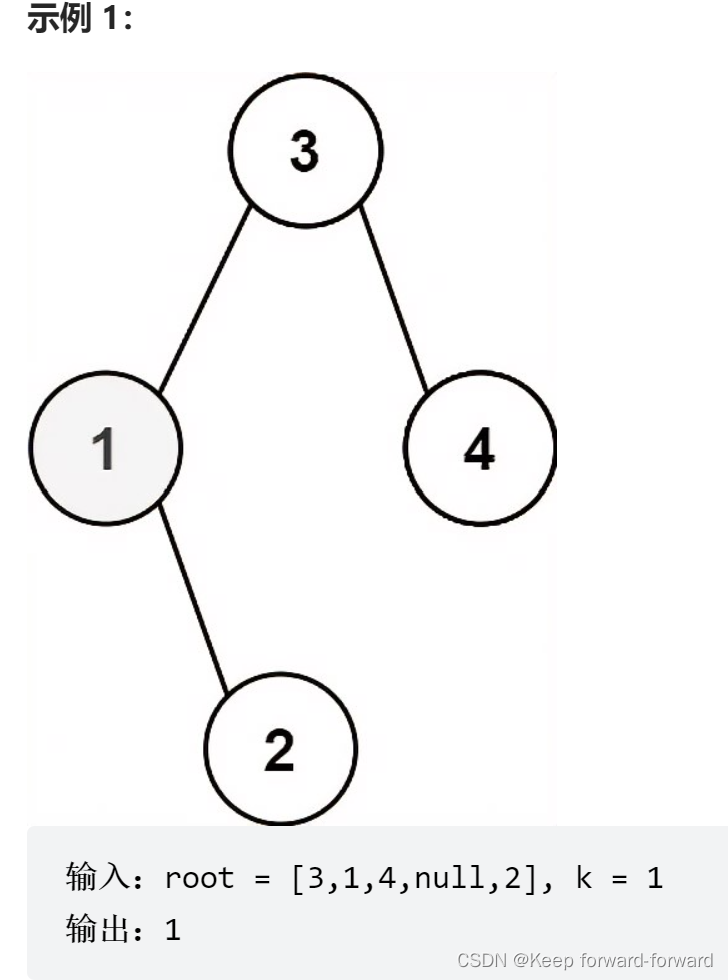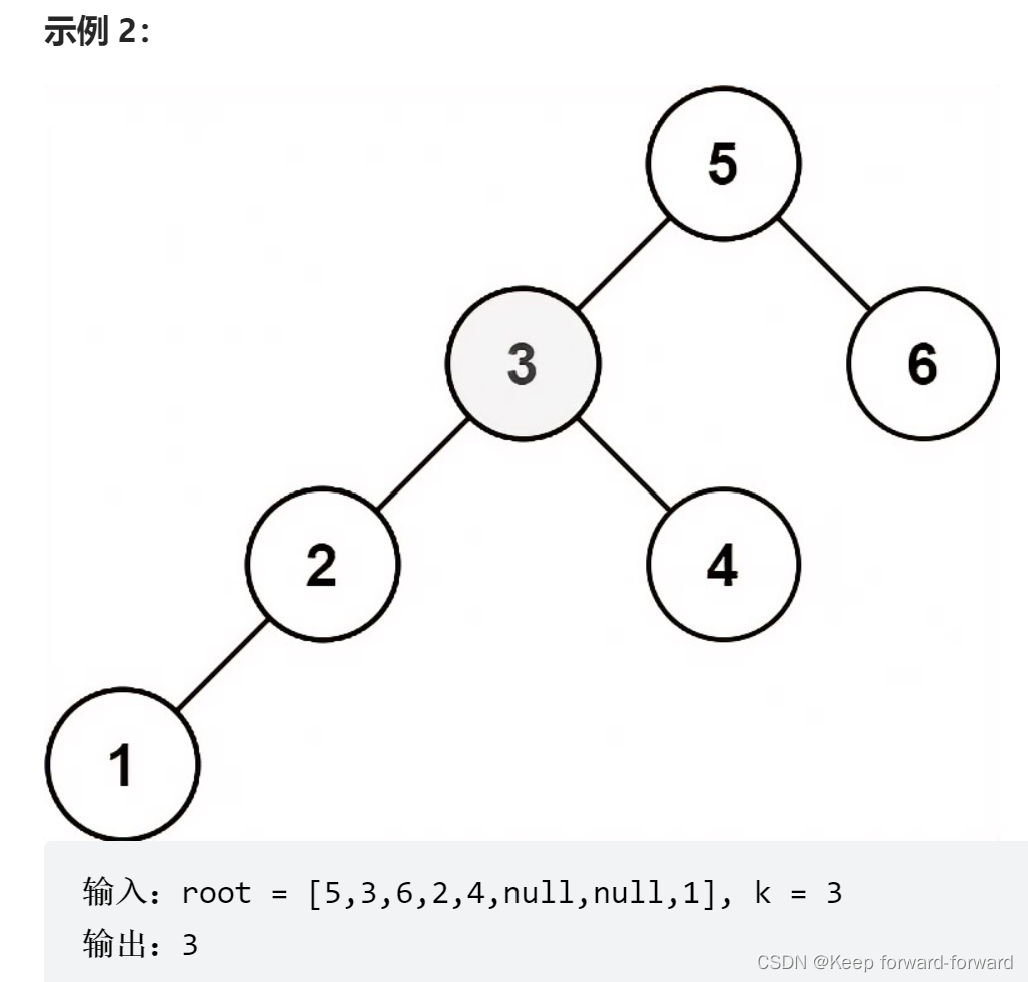一、题目
给定一个二叉搜索树的根节点 root ,和一个整数 k ,请你设计一个算法查找其中第 k 个最小元素(从 1 开始计数)。


二、思路
1.层序遍历
因为二叉搜索树和中序遍历的性质,所以二叉搜索树的中序遍历是按照键增加的顺序进行的。于是,我们可以通过中序遍历找到第 kk 个最小元素。
2.记录子树的节点树
我们可以记录下以每个结点为根结点的子树的结点数,并在查找第 k 小的值时,使用如下方法搜索:
令 node 等于根结点,开始搜索。
对当前结点 \textit{node}node 进行如下操作:
1)如果node 的左子树的结点数left 小于k−1,则第 k 小的元素一定在node 的右子树中,令node 等于其的右子结点,kk等于 k−left−1,并继续搜索;
2)如果node 的左子树的结点数left 等于 k−1,则第 k 小的元素即为node ,结束搜索并返回 node 即可;
3)如果 node 的左子树的结点数 left 大于 k−1,则第 k 小的元素一定在 node 的左子树中,令 node 等于其左子结点,并继续搜索。
在实现中,我们既可以将以每个结点为根结点的子树的结点数存储在结点中,也可以将其记录在哈希表中
3.平衡二叉搜索树
我们注意到在方法二中搜索二叉搜索树的时间复杂度为 O(H),其中 H是树的高度;当树是平衡树时,时间复杂度取得最小值 O(logN)。因此,我们在记录子树的结点数的基础上,将二叉搜索树转换为平衡二叉搜索树,并在插入和删除操作中维护它的平衡状态。
三、知识点
1.二叉搜索树具有如下性质:
结点的左子树只包含小于当前结点的数。
结点的右子树只包含大于当前结点的数。
所有左子树和右子树自身必须也是二叉搜索树。
二叉树的中序遍历即按照访问左子树——根结点——右子树的方式遍历二叉树;在访问其左子树和右子树时,我们也按照同样的方式遍历;直到遍历完整棵树。
2.平衡二叉搜索树的性质:
平衡二叉搜索树中每个结点的左子树和右子树的高度最多相差 1;
平衡二叉搜索树的子树也是平衡二叉搜索树;
一棵存有 n 个结点的平衡二叉搜索树的高度是 O(logn)。
四、代码
1.中序遍历C++
class Solution {
public:
int kthSmallest(TreeNode* root, int k) {
stack<TreeNode *> stack;
while (root != nullptr || stack.size() > 0) {
while (root != nullptr) {
stack.push(root);
root = root->left;
}
root = stack.top();
stack.pop();
--k;
if (k == 0) {
break;
}
root = root->right;
}
return root->val;
}
};
2.获取节点树C++
class MyBst {
public:
MyBst(TreeNode *root) {
this->root = root;
countNodeNum(root);
}
// 返回二叉搜索树中第k小的元素
int kthSmallest(int k) {
TreeNode *node = root;
while (node != nullptr) {
int left = getNodeNum(node->left);
if (left < k - 1) {
node = node->right;
k -= left + 1;
} else if (left == k - 1) {
break;
} else {
node = node->left;
}
}
return node->val;
}
private:
TreeNode *root;
unordered_map<TreeNode *, int> nodeNum;
// 统计以node为根结点的子树的结点数
int countNodeNum(TreeNode * node) {
if (node == nullptr) {
return 0;
}
nodeNum[node] = 1 + countNodeNum(node->left) + countNodeNum(node->right);
return nodeNum[node];
}
// 获取以node为根结点的子树的结点数
int getNodeNum(TreeNode * node) {
if (node != nullptr && nodeNum.count(node)) {
return nodeNum[node];
}else{
return 0;
}
}
};
class Solution {
public:
int kthSmallest(TreeNode* root, int k) {
MyBst bst(root);
return bst.kthSmallest(k);
}
};
3.C++平衡二叉树
// 平衡二叉搜索树结点
struct Node {
int val;
Node * parent;
Node * left;
Node * right;
int size;
int height;
Node(int val) {
this->val = val;
this->parent = nullptr;
this->left = nullptr;
this->right = nullptr;
this->height = 0; // 结点高度:以node为根节点的子树的高度(高度定义:叶结点的高度是0)
this->size = 1; // 结点元素数:以node为根节点的子树的节点总数
}
Node(int val, Node * parent) {
this->val = val;
this->parent = parent;
this->left = nullptr;
this->right = nullptr;
this->height = 0; // 结点高度:以node为根节点的子树的高度(高度定义:叶结点的高度是0)
this->size = 1; // 结点元素数:以node为根节点的子树的节点总数
}
Node(int val, Node * parent, Node * left, Node * right) {
this->val = val;
this->parent = parent;
this->left = left;
this->right = right;
this->height = 0; // 结点高度:以node为根节点的子树的高度(高度定义:叶结点的高度是0)
this->size = 1; // 结点元素数:以node为根节点的子树的节点总数
}
};
// 平衡二叉搜索树(AVL树):允许重复值
class AVL {
public:
AVL(vector<int> & vals) {
if (!vals.empty()) {
root = build(vals, 0, vals.size() - 1, nullptr);
}
}
// 根据vals[l:r]构造平衡二叉搜索树 -> 返回根结点
Node * build(vector<int> & vals, int l, int r, Node * parent) {
int m = (l + r) >> 1;
Node * node = new Node(vals[m], parent);
if (l <= m - 1) {
node->left = build(vals, l, m - 1, node);
}
if (m + 1 <= r) {
node->right = build(vals, m + 1, r, node);
}
recompute(node);
return node;
}
// 返回二叉搜索树中第k小的元素
int kthSmallest(int k) {
Node * node = root;
while (node != nullptr) {
int left = getSize(node->left);
if (left < k - 1) {
node = node->right;
k -= left + 1;
} else if (left == k - 1) {
break;
} else {
node = node->left;
}
}
return node->val;
}
void insert(int v) {
if (root == nullptr) {
root = new Node(v);
} else {
// 计算新结点的添加位置
Node * node = subtreeSearch(root, v);
bool isAddLeft = v <= node->val; // 是否将新结点添加到node的左子结点
if (node->val == v) { // 如果值为v的结点已存在
if (node->left != nullptr) { // 值为v的结点存在左子结点,则添加到其左子树的最右侧
node = subtreeLast(node->left);
isAddLeft = false;
} else { // 值为v的结点不存在左子结点,则添加到其左子结点
isAddLeft = true;
}
}
// 添加新结点
Node * leaf = new Node(v, node);
if (isAddLeft) {
node->left = leaf;
} else {
node->right = leaf;
}
rebalance(leaf);
}
}
// 删除值为v的结点 -> 返回是否成功删除结点
bool Delete(int v) {
if (root == nullptr) {
return false;
}
Node * node = subtreeSearch(root, v);
if (node->val != v) { // 没有找到需要删除的结点
return false;
}
// 处理当前结点既有左子树也有右子树的情况
// 若左子树比右子树高度低,则将当前结点替换为右子树最左侧的结点,并移除右子树最左侧的结点
// 若右子树比左子树高度低,则将当前结点替换为左子树最右侧的结点,并移除左子树最右侧的结点
if (node->left != nullptr && node->right != nullptr) {
Node * replacement = nullptr;
if (node->left->height <= node->right->height) {
replacement = subtreeFirst(node->right);
} else {
replacement = subtreeLast(node->left);
}
node->val = replacement->val;
node = replacement;
}
Node * parent = node->parent;
Delete(node);
rebalance(parent);
return true;
}
private:
Node * root;
// 删除结点p并用它的子结点代替它,结点p至多只能有1个子结点
void Delete(Node * node) {
if (node->left != nullptr && node->right != nullptr) {
return;
// throw new Exception("Node has two children");
}
Node * child = node->left != nullptr ? node->left : node->right;
if (child != nullptr) {
child->parent = node->parent;
}
if (node == root) {
root = child;
} else {
Node * parent = node->parent;
if (node == parent->left) {
parent->left = child;
} else {
parent->right = child;
}
}
node->parent = node;
}
// 在以node为根结点的子树中搜索值为v的结点,如果没有值为v的结点,则返回值为v的结点应该在的位置的父结点
Node * subtreeSearch(Node * node, int v) {
if (node->val < v && node->right != nullptr) {
return subtreeSearch(node->right, v);
} else if (node->val > v && node->left != nullptr) {
return subtreeSearch(node->left, v);
} else {
return node;
}
}
// 重新计算node结点的高度和元素数
void recompute(Node * node) {
node->height = 1 + max(getHeight(node->left), getHeight(node->right));
node->size = 1 + getSize(node->left) + getSize(node->right);
}
// 从node结点开始(含node结点)逐个向上重新平衡二叉树,并更新结点高度和元素数
void rebalance(Node * node) {
while (node != nullptr) {
int oldHeight = node->height, oldSize = node->size;
if (!isBalanced(node)) {
node = restructure(tallGrandchild(node));
recompute(node->left);
recompute(node->right);
}
recompute(node);
if (node->height == oldHeight && node->size == oldSize) {
node = nullptr; // 如果结点高度和元素数都没有变化则不需要再继续向上调整
} else {
node = node->parent;
}
}
}
// 判断node结点是否平衡
bool isBalanced(Node * node) {
return abs(getHeight(node->left) - getHeight(node->right)) <= 1;
}
// 获取node结点更高的子树
Node * tallChild(Node * node) {
if (getHeight(node->left) > getHeight(node->right)) {
return node->left;
} else {
return node->right;
}
}
// 获取node结点更高的子树中的更高的子树
Node * tallGrandchild(Node * node) {
Node * child = tallChild(node);
return tallChild(child);
}
// 重新连接父结点和子结点(子结点允许为空)
static void relink(Node * parent, Node * child, bool isLeft) {
if (isLeft) {
parent->left = child;
} else {
parent->right = child;
}
if (child != nullptr) {
child->parent = parent;
}
}
// 旋转操作
void rotate(Node * node) {
Node * parent = node->parent;
Node * grandparent = parent->parent;
if (grandparent == nullptr) {
root = node;
node->parent = nullptr;
} else {
relink(grandparent, node, parent == grandparent->left);
}
if (node == parent->left) {
relink(parent, node->right, true);
relink(node, parent, false);
} else {
relink(parent, node->left, false);
relink(node, parent, true);
}
}
// trinode操作
Node * restructure(Node * node) {
Node * parent = node->parent;
Node * grandparent = parent->parent;
if ((node == parent->right) == (parent == grandparent->right)) { // 处理需要一次旋转的情况
rotate(parent);
return parent;
} else { // 处理需要两次旋转的情况:第1次旋转后即成为需要一次旋转的情况
rotate(node);
rotate(node);
return node;
}
}
// 返回以node为根结点的子树的第1个元素
static Node * subtreeFirst(Node * node) {
while (node->left != nullptr) {
node = node->left;
}
return node;
}
// 返回以node为根结点的子树的最后1个元素
static Node * subtreeLast(Node * node) {
while (node->right != nullptr) {
node = node->right;
}
return node;
}
// 获取以node为根结点的子树的高度
static int getHeight(Node * node) {
return node != nullptr ? node->height : 0;
}
// 获取以node为根结点的子树的结点数
static int getSize(Node * node) {
return node != nullptr ? node->size : 0;
}
};
class Solution {
public:
int kthSmallest(TreeNode * root, int k) {
// 中序遍历生成数值列表
vector<int> inorderList;
inorder(root, inorderList);
// 构造平衡二叉搜索树
AVL avl(inorderList);
// 模拟1000次插入和删除操作
vector<int> randomNums(1000);
std::random_device rd;
for (int i = 0; i < 1000; ++i) {
randomNums[i] = rd()%(10001);
avl.insert(randomNums[i]);
}
shuffle(randomNums); // 列表乱序
for (int i = 0; i < 1000; ++i) {
avl.Delete(randomNums[i]);
}
return avl.kthSmallest(k);
}
private:
void inorder(TreeNode * node, vector<int> & inorderList) {
if (node->left != nullptr) {
inorder(node->left, inorderList);
}
inorderList.push_back(node->val);
if (node->right != nullptr) {
inorder(node->right, inorderList);
}
}
void shuffle(vector<int> & arr) {
std::random_device rd;
int length = arr.size();
for (int i = 0; i < length; i++) {
int randIndex = rd()%length;
swap(arr[i],arr[randIndex]);
}
}
};
五、总结
1.层序遍历复杂度
时间复杂度:O(H+k),其中 H 是树的高度。在开始遍历之前,我们需要 OO(H) 到达叶结点。
当树是平衡树时,时间复杂度取得最小值 O(logN+k);
当树是线性树(树中每个结点都只有一个子结点或没有子结点)时,时间复杂度取得最大值 O(N+k)。
空间复杂度:O(H),栈中最多需要存储 H 个元素。当树是平衡树时,空间复杂度取得最小值 O(logN);当树是线性树时,空间复杂度取得最大值 O(N)。
2.获取节点数
时间复杂度:预处理的时间复杂度为 O(N),其中 N 是树中结点的总数;我们需要遍历树中所有结点来统计以每个结点为根结点的子树的结点数。搜索的时间复杂度为 O(H),其中 H 是树的高度;当树是平衡树时,时间复杂度取得最小值 O(logN);当树是线性树时,时间复杂度取得最大值 O(N)。
空间复杂度:O(N),用于存储以每个结点为根结点的子树的结点数。
3.平衡二叉树
时间复杂度:预处理的时间复杂度为 OO(N),其中 NN 是树中结点的总数。插入、删除和搜索的时间复杂度均为 O(logN)。
空间复杂度:O(N),用于存储平衡二叉搜索树。

























 298
298











 被折叠的 条评论
为什么被折叠?
被折叠的 条评论
为什么被折叠?








